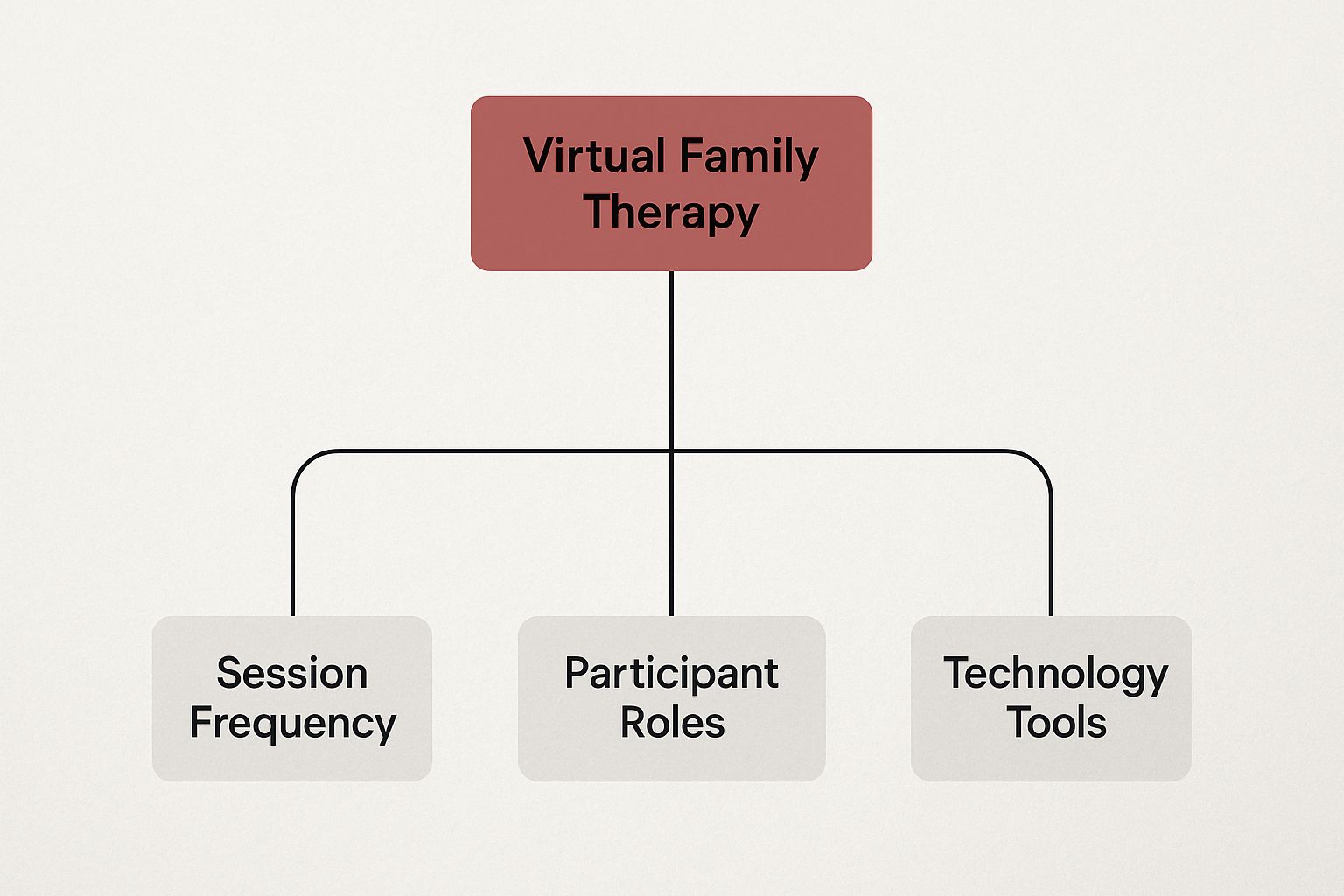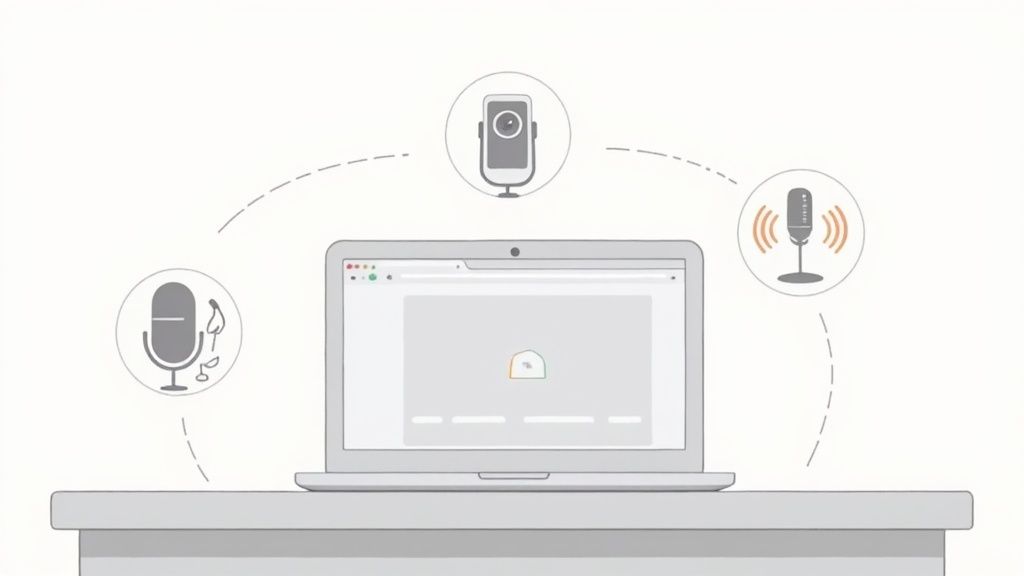Virtual family therapy is a way to heal relationships and improve communication, all without having to get everyone in the same room. It's like a guided family meeting, but it happens in a secure, private online space with a trained therapist leading the way. Technology simply provides the bridge to connect everyone, no matter where they might be.
Understanding the New Landscape of Family Healing
Thinking of virtual therapy as just a stand-in for in-person sessions doesn't quite capture the full picture. It's a powerful and effective approach in its own right for resolving conflicts, improving how you talk to each other, and rebuilding family bonds. It’s built for the realities of modern life, where schedules are packed and family members might live miles apart.
Instead of trying to coordinate everyone's travel to an office, sessions take place on secure video platforms. This accessibility alone often makes it easier for the whole family to show up consistently, which is a huge factor in whether therapy is successful. Plus, being in the comfort of your own home can help everyone, especially kids and teens, relax and open up.
The core idea is simple: a family is an interconnected system. The actions and feelings of one person naturally affect everyone else. Virtual therapy provides a structured space to explore these connections and build healthier patterns.
The image below breaks down the key parts that make up a typical virtual family therapy experience.

As you can see, technology, the role of each participant, and the frequency of sessions all work together to support the process. This model is becoming more and more common, and the numbers back it up. The global online therapy services market was valued at approximately USD 4.39 billion in 2025 and is expected to grow to around USD 14.10 billion by 2034.
Key Goals in Virtual Sessions
A therapist’s main job is to create a balanced and productive online space where everyone feels heard. The primary goals we often work toward include:
- Improving Communication: Learning how to express your needs clearly and listen with intention, even through a screen.
- Resolving Conflicts: Finding practical strategies to navigate disagreements without them escalating.
- Strengthening Bonds: Rebuilding trust and fostering a real sense of connection and teamwork among family members.
These goals are at the heart of what we do. Our approach to family therapy is designed to guide your family through this process, one session at a time.
The Real Benefits of Online Family Counseling
Let's be honest—getting the whole family to a therapist's office can be a logistical nightmare. Taking therapy online removes so many of those practical roadblocks that often stop families from even starting. The most obvious win? No more travel time, and no more stress trying to sync everyone's schedule for an in-person visit.
For families juggling work, school, and after-school activities, finding a one-hour slot for a virtual session is so much more doable than blocking out three hours for travel and the appointment itself. This simple convenience makes it far more likely that families will stick with therapy, which is one of the biggest factors in making real progress.
This improved access isn't just for busy families, either. Virtual therapy opens doors for families who are physically apart. Think of a co-parent living in another town or a young adult away at college. Online sessions ensure everyone has a seat at the table and can participate equally.
Creating a More Comfortable and Open Environment
Where therapy happens can make a huge difference in how much people are willing to open up. For a lot of people, especially kids and teenagers, the comfort of their own home can help lower their guard and take the edge off the anxiety that sometimes comes with a formal, clinical office.
When you're in your own personal, safe space, you tend to feel more relaxed and can be more yourself. This often leads to more honest and open conversations, right from the very beginning. A teenager might feel more comfortable talking from their bedroom, or a young child might feel braver with their favorite toys right beside them.
When families feel safe and comfortable, they are better equipped to explore their emotions and relational patterns. The therapist's role is to leverage this comfort to guide the family toward healthier interactions and connections.
Key Advantages of Choosing Virtual Sessions
The move to an online format brings several clear, practical benefits that directly support a family's well-being. These advantages make therapy a realistic and accessible option for many more families.
- Improved Accessibility: It completely breaks down geographical barriers, making specialized therapy available even if you live in a remote area or have challenges with mobility.
- Scheduling Flexibility: Sessions can be booked around complex family schedules, which cuts down on conflicts and makes it much easier to attend sessions consistently.
- Increased Comfort: The home environment helps many people, particularly younger family members, feel more secure and ready to engage in the therapeutic process.
Ultimately, by getting rid of these common hurdles, virtual family therapy offers a practical and effective way forward for building stronger, healthier family relationships.
How to Navigate Common Online Therapy Challenges
To get the most out of every session, it helps to be ready for a few potential hurdles. Moving therapy online brings new variables into the mix, but with a little bit of prep work, you can manage them easily and keep the space productive. A proactive approach is really the key to a smooth experience.
The most common issues are usually technical. A spotty internet connection or a frozen screen can completely derail the flow of a sensitive conversation. At the same time, finding a truly private space in a busy house can feel next to impossible, raising valid concerns about confidentiality.
These issues aren't just unique to therapy. Many of the hiccups in virtual family therapy are similar to those in other remote settings. Learning about overcoming common remote work challenges can give you even more helpful strategies for creating a successful virtual environment.
Setting Your Family Up for Success
To build a strong foundation for your sessions, your main focus should be on creating structure and cutting down on potential disruptions. Small, practical steps can make a world of difference in the quality of your family's virtual therapy experience.
Before you even log on for your first session, take a moment to get your space and tech ready. These proactive measures help head off the most common frustrations and make sure your family can focus on what really matters—healing and connecting.
Here are a few actionable tips to get you started:
- Test Your Tech: Do a quick trial run on your video platform. Check your camera, mic, and internet connection about 15 minutes before the session is scheduled to start. This gives you time to fix any glitches ahead of time.
- Create a Privacy Plan: Agree on a designated, quiet room for therapy. Using headphones is a simple but incredibly effective way to ensure conversations stay confidential and to block out background noise.
- Establish Boundaries: Let everyone else in the house know when therapy is happening. A simple sign on the door can prevent interruptions and signal that this time is protected.
Managing 'screen fatigue' is also important. If you can, try to avoid scheduling other long video calls right before or after your therapy session. This helps everyone stay fresh and engaged.
By anticipating these minor roadblocks, you empower your family to engage more fully in the process. These simple solutions help turn your home into a reliable and supportive setting for truly productive virtual family therapy.
What to Expect in Your First Virtual Session
It’s completely normal to feel a little nervous before your first virtual family therapy session. Stepping into any new process can feel uncertain, but knowing what to expect can go a long way in easing those jitters. The first meeting is really about setting the stage for productive work, establishing a safe space, and simply getting to know each other.
Your therapist will start by walking you through some simple ground rules for respectful online communication. This isn't about being rigid; it's about making sure everyone feels safe, seen, and heard. Think of it as building the container for your work together—a place where honest conversations can finally happen.
The session will likely begin with an initial intake, where the therapist gathers some history to understand what brought your family to therapy. This is usually followed by a quick, straightforward tech check and a walkthrough of the platform to make sure everyone is comfortable.
Establishing a Productive Flow
A huge part of the therapist's role in virtual family therapy is to moderate the conversation so it doesn't spiral into chaos. They act as a neutral guide, ensuring one person doesn't dominate the discussion and that quieter family members have the space to share. This is absolutely crucial for building trust.
To manage this, therapists use specific techniques to maintain focus and balance. A skilled therapist might use an approach that functions like a "digital talking stick," giving each person a dedicated turn to speak without interruption. This simple structure helps transform potential arguments into constructive dialogue.
This managed flow is what makes real progress possible. It allows the therapist to see family dynamics in real-time and gently guide interactions toward healthier patterns. You can explore more tools for building healthy family habits on our resources page.
Your first session isn't about finding instant solutions. It's about building a foundation of trust and understanding. All future progress grows from there. The main goal is to make everyone feel comfortable enough to start the journey.
This approach is proving to be not only effective but also highly preferred. Recent data shows that over 86% of teletherapy users report satisfaction, with 55.5% now favoring digital therapy over traditional in-person meetings. You can learn more about the growing acceptance of teletherapy from these statistics.
How We Bring Family Healing into the Online Space
Creating a genuinely supportive therapy environment online is at the heart of everything we do. At The Sachs Center, our approach to virtual family therapy isn't just about turning on a camera; it’s about translating the power of human connection into a digital space so your family feels heard, understood, and guided every step of the way.
Think of our telehealth model as more than just a video call. It’s a carefully structured, secure process managed by therapists who are specially trained to read a room, even through a screen. They are experts at picking up on digital body language—the subtle shifts in expression, tone, and posture that tell the real story—so no one’s feelings get lost in translation.
A Secure and Thoughtful Telehealth Model
We get it. Trust is the bedrock of good therapy. That’s why we use secure, easy-to-use platforms that are fully HIPAA-compliant to protect your family’s privacy. From the first click to your last session, our system is designed to be straightforward, letting you focus on what really matters: healing, not troubleshooting tech.
This focus on a secure, accessible model is more important than ever as families increasingly seek out online support. Mental healthcare is evolving, and it's projected that the global online therapy services market will grow by USD 64.1 billion between 2025 and 2029, driven by demand for convenient and effective digital care. You can dive deeper into the intersection of AI and online therapy in this market analysis.
Practical Healing in Action
So, what does this actually look like? Let’s take a real-world (anonymized) example: a family caught in a cycle of arguments after a major life change. In our virtual sessions, the therapist first sets clear ground rules for communication, making sure everyone gets to speak without being interrupted.
By guiding the conversation, the therapist helps the family see past the surface-level bickering to the root of the conflict—unexpressed grief and anxiety. This is where real healing begins.
For families navigating a loss, incorporating specific grief therapy exercises can also provide powerful tools for processing emotions together. Our methods are designed to help you tackle these tough issues head-on, turning moments of breakdown into opportunities for breakthrough. We empower you with strategies to communicate better and rebuild your bonds, helping your family move toward a more connected and hopeful future.
Frequently Asked Questions
Stepping into therapy for the first time, especially online, can bring up a lot of questions. We get it. This section gives you clear, straightforward answers to the most common concerns we hear from families, so you can feel confident and prepared for your first session.
Is Virtual Therapy as Effective as Meeting in Person?
Absolutely. For many families, virtual therapy is just as effective as traditional in-person sessions. We've seen it time and time again, and the research and high satisfaction rates back this up.
What really makes therapy successful isn't the setting—it's the family's commitment to showing up and doing the work, and the skill of the therapist leading the sessions. A therapist who is experienced in the online format knows how to build real connection and guide meaningful conversations, even through a screen. At the end of the day, it’s all about creating a strong therapeutic relationship, which is entirely possible in a virtual space.
How Do You Ensure Our Sessions Are Private and Secure?
We take your family's privacy and confidentiality very seriously. All our sessions happen on HIPAA-compliant video platforms that use end-to-end encryption. This is a fancy way of saying the technology ensures your conversations are completely protected and private from our end.
Of course, privacy is a two-way street. We always recommend a few simple but important steps you can take on your end:
- Find a Private Space: Try to use a quiet, enclosed room where you won't be interrupted.
- Use Headphones: This is an easy way to prevent others in your home from overhearing the conversation.
- Secure Your Connection: Always use a password-protected, secure internet connection, not public Wi-Fi.
Your therapist will go over all of these confidentiality measures with you in your first session to make sure everyone feels safe and comfortable.
What Happens if We Have Technical Problems During a Session?
Tech glitches happen—it's just a reality of our online world, and we're always prepared for them. During your first meeting, your therapist will work with you to set up a clear backup plan in case of any disruptions.
Usually, this means we’ll simply switch to a phone call if the video connection drops, so the session can continue without missing a beat. We also find that doing a quick tech check before each session (just testing your audio and video) helps prevent most common issues from popping up in the first place. For more answers to common questions, you can always check out our detailed FAQ page.
How Do Therapists Manage the Conversation So Everyone Gets to Talk?
This is a great question. Our therapists are specifically trained to moderate group dynamics in an online setting. They don't just let the conversation run wild; they use structured techniques to make sure every family member has a fair chance to speak without being talked over or feeling left out.
For example, a therapist might gently guide the conversation by inviting individuals to share their thoughts or use virtual cues to manage the flow of the discussion. This active moderation is key to building a balanced and respectful environment where everyone feels heard and valued—which is really the foundation of productive virtual family therapy.
At The Sachs Center, we specialize in creating a supportive and effective telehealth environment where families can heal and grow. If you're ready to take the next step toward building stronger connections, we invite you to book an evaluation with our expert team. Book your appointment today.


